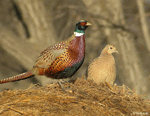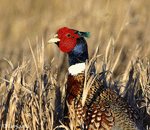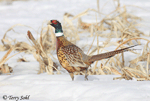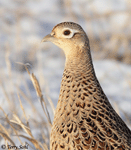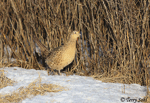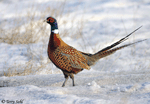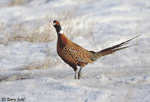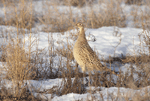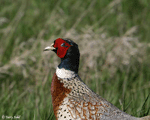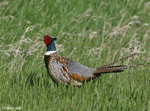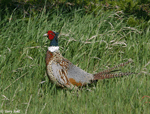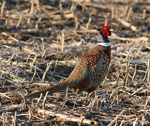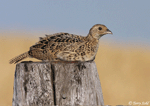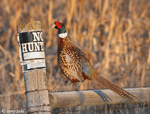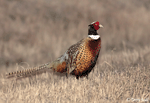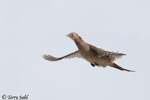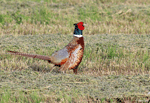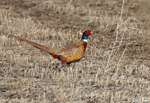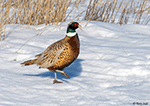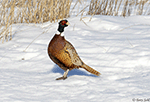| Length: 21 - 33 inches | Wingspan: 28 - 34 inches | Seasonality: Permanent Resident |
| ID Keys: Male distinctive, with red face wattles, white neck ring, colorful body | ||
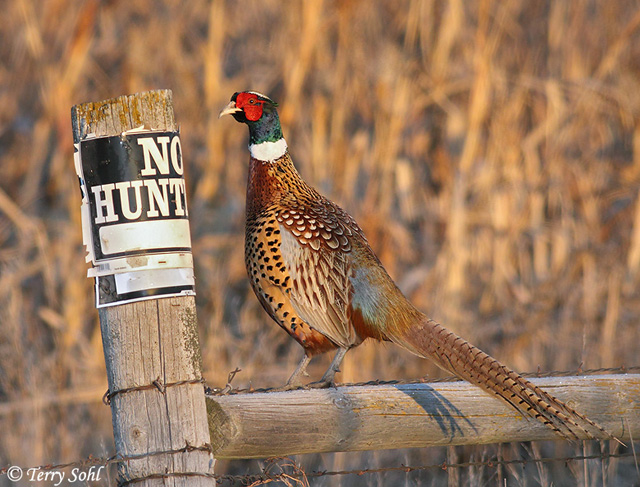 The state bird of South
Dakota, and for good reason (economically anyway). Ring-necked Pheasant hunting in the state is renowned,
attracting thousands of out of state hunters and bringing millions of dollars of
revenue into the state. The Ring-necked Pheasant is an introduced species,
native to Asia. It was first introduced into the United States in 1857,
and has become well established throughout much of the Midwest, the Plains
states, and parts of the West. The photo on the right shows a mature male.
The state bird of South
Dakota, and for good reason (economically anyway). Ring-necked Pheasant hunting in the state is renowned,
attracting thousands of out of state hunters and bringing millions of dollars of
revenue into the state. The Ring-necked Pheasant is an introduced species,
native to Asia. It was first introduced into the United States in 1857,
and has become well established throughout much of the Midwest, the Plains
states, and parts of the West. The photo on the right shows a mature male.
Habitat:
Nearly all open upland habitat in the state, including farm fields, rangeland, brush, woodland edges, hedgerows.
Diet:
Omnivorous, feeding on grains, seeds, roots, berries, buds, acorns, insects, earthworms, snails, and occasionally mice, snakes, and frogs.
Behavior:
Nearly always forages on the ground, often scratching on the ground with feet or bill to find food.
Nesting:
May through June. The nest is a shallow depression lined with vegetative material such as grasses and weeds, placed on the ground in dense cover. The female lays between 7 and 14 eggs, and she alone incubates them. When the eggs hatch, the young leave the nest almost immediately, with the female tending to the young. The young feed themselves while under the female's care.
Song:
Harsh croaking notes when alarmed. Males make loud crowing khaaaa-cack.
- Click here to hear a harsh clucking sound of a male Ring-necked Pheasant1
- Click here to hear more typical calls of a male Ring-necked Pheasant2
- Click here to hear the typical flight calls of a Ring-necked Pheasant3
Migration:
Permanent Resident
Interactive eBird map:
Click here to access an interactive eBird map of Ring-necked Pheasant sightings
Similar Species:
Males generally distinctive. Females could possibly be confused with Sharp-tailed Grouse or Greater Prairie Chicken.
Feeders:
Ring-necked Pheasants will sometimes visit feeders for various seeds scattered on the ground.
Status:
Abundant and widespread. Although populations in their native lands are in decline, populations in North America are strong, no doubt helped in part by continuous stocking of birds in some areas where hunting is popular. The IUCN lists the Ring-necked Pheasant as a species of "Least Concern".
Further Information:
- Patuxent Bird Identification InfoCenter, Ring-necked Pheasant
- BirdWeb - Ring-necked Pheasant
- Whatbird - Ring-necked Pheasant
Photo Information:
February 16th, 2004 -- Near Presho -- Terry Sohl
Additional Photos:
Click on the image chips or text links below for additional, higher-resolution Ring-necked Pheasant photos.
Audio File Credits:
- 1Krzysztof Deoniziak. Recorded in Poland on April 3rd, 2015. Original recording and information available from xeno-canto.
- 2Tom Burke. Recorded in China on June 20th, 2015. Original recording and information available from xeno-canto.
- 3Stanislas Wroza. Recorded in France on December 15th, 2020. Original recording and information available from xeno-canto.
| Click on the map below for a higher-resolution view |
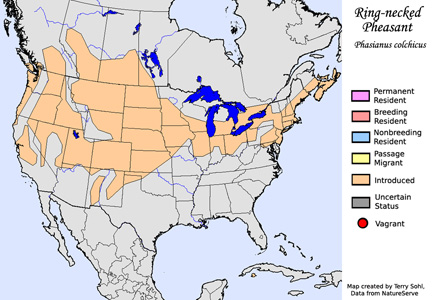 |
| South Dakota Status: Widespread and locally abundant. Wild populations are often augmented with stocked birds to facilitate hunting. |
Additional Ring-necked Pheasant Photos
Click for a higher-resolution version of these photos
